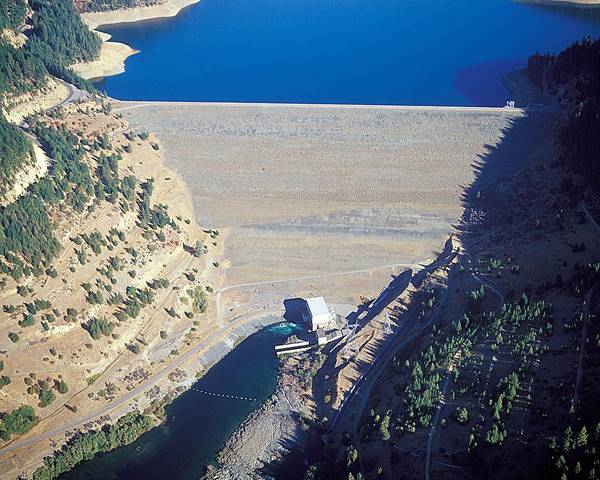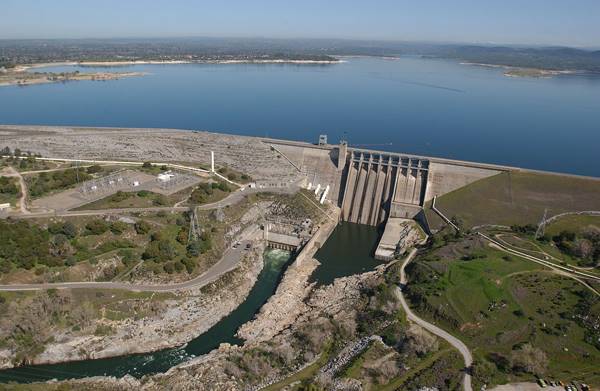Making Dams in California Fish-Friendly
 The Trinity Dam on the Trinity River is one of the dams flagged by the study (Credit: Michael Nevins/U.S. Bureau of Reclamation)
The Trinity Dam on the Trinity River is one of the dams flagged by the study (Credit: Michael Nevins/U.S. Bureau of Reclamation)Scattered throughout California’s waterways are hundreds of federal and privately owned dams. While some dams simply help with flood control and can store water for irrigation, others are hydroelectric plants that provide energy to the region. While dams can be beneficial for communities, they can harm the local ecosystem of the rivers they are installed in.
Salmon and other migratory fish specifically have been negatively impacted by dams as the fish can no longer freely travel up and down the river to spawn. Fish that permanently reside in the area below the dam face possible hypoxia, increased turbidity, and temperature fluctuations due to outputs from the dam, all of which can influence fish health and behavior.
Cognizant of declining fish biodiversity and the impacts dams can have on these native populations, the Center for Watershed Sciences at the University of California, Davis, created a framework that identifies which dams are causing problems.
The framework was applied to 753 of California’s largest dams in a 2014 study published by BioScience. The screening-level tool flagged 181 high-priority dams showing signs of hydrologic alteration and ecological impairment near where several threatened species live.
According to Ted Grantham, former USGS research biologist and lead author of the study, the framework could be applied globally in order to help resource managers identify rivers and dams of concern. Once identified dam operators can make informed modifications to current practices.
With such a high volume of dams spread throughout the state, Grantham poses the question of “Where do we start?”
Fortunately, the framework’s data provides managers with an objective starting point.
Environmental Dam Changes
The goal of the UC Davis framework was for dam operators and policymakers to utilize the data to identify areas for restoration. As with many environmental projects, managers must balance limited funds and resources–these dam and river restoration projects are no different, making starting the projects challenging.
While the framework gives operators a place to start by flagging dams with larger impacts on their environments, Grantham recommends referring to the California Fish and Game Code 5937 for guidance on meaningfully implementing sustainable practices.
For example, according to NOAA Fisheries, when spring-run Chinook salmon went missing from the San Joaquin River for 60 years, the code jump-started a water management and restoration program to help managers adjust streamflows.
Originally, the Friant Dam on the San Joaquin River diverted water to canals and irrigation, causing parts of the river to begin drying up and disconnecting Chinook salmon from their native habitat.
The restoration program guided Friant Dam operators as they made changes to sustain local biodiversity and Chinook salmon by releasing more water into the river and restoring streamflows long-term.
“Regardless of who owns the dam or what you’re managing for, you have to leave enough water to keep the fish alive and in good condition,” explains Grantham.
Repairing streamflows is essential to restoring salmon populations obstructed by California dams. According to NOAA Fisheries, California dams have blocked almost 90 percent of adult salmon and steelhead spawning and rearing habitat. A popular method of flow restoration involves releasing water from the reservoir into the river to help improve conditions below the dam, though the dams are still a barrier to migration.
Multiple other large dams are working to restore rivers in order to support salmon migration and habitat needs. For example, the Klamath Dam removal is America’s biggest dam removal project, removing four dams due to major water quality problems and salmon migration impediments.
While salmon are culturally important to Californians, many other native fish species in the state are threatened, like dace, suckers, chubs, and more. If nothing changes in the next century, Grantham warns that around 80 percent of California’s fish species will be threatened by extinction, endangering a wide array of the state’s fish that aren’t found anywhere else on Earth.

Folsom Dam on the American River is one of the dams flagged by the study (Credit: Michael Nevins/U.S. Army Corps of Engineers)
Small Changes to Dam Operations For Big Benefits
Operational dam changes can sound discouraging to farmers and others who benefit from them, but according to Grantham, the inevitable tradeoffs of managing the dams for fish aren’t as severe as people might expect.
Identifying areas of concern using the framework allows managers to decide how to restore those areas while considering ecological, social, and economic factors. Depending on the needs of the region, small changes can be made to protect the environment. For example, changes to water release timing in Putah Creek benefited native fish communities with only small increases in water release annually.
“You don’t need to restore a completely natural flow regime. You just need to restore the key elements that the species are really adapted to,” Grantham explains. “It’s all about releasing water at biologically critical times of the year.”
In 2000, Monticello Dam managers were instructed to implement new environmental flows for Putah Creek to promote natural streamflows for the native fish species and prevent the creek from drying up in the drought.
Grantham contributed to analyzing environmental streamflow data in a 2024 study published by Ecological Applications. The study compiled 25 years of sampling data between 1993 and 2019 (excluding 2009 and 2011) in order to understand the impacts of the environmental streamflows on the fishing community.
Notably, researchers found that native fish benefited from even small changes that helped achieve more natural streamflows, while non-native fish species prefer deviated flows.
Due to the limited long-term data on fish responses to flow changes, researchers suggest more critical evaluations are needed to direct future flow restorations.
Conclusion
The framework can help guide future restoration initiatives and strategies in dams and rivers that are deemed to be most in need of reform. Implementing more dam and stream monitoring and assessment programs will reveal what methods work in aiding fish streamflows.
While the framework is a helpful tool, not every dam on the list violates fish laws or damages fish populations. Instead, the list is simply a resource for managers to strategically find places where fish face stressors, like ecological and hydrologic impairment so that dam operators can work to prioritize improving the dams to be fish-friendly while still functional.
“This idea that we need a way to prioritize the rivers on which we focus our conservation attention–that has global resonance,” said Grantham.



0 comments